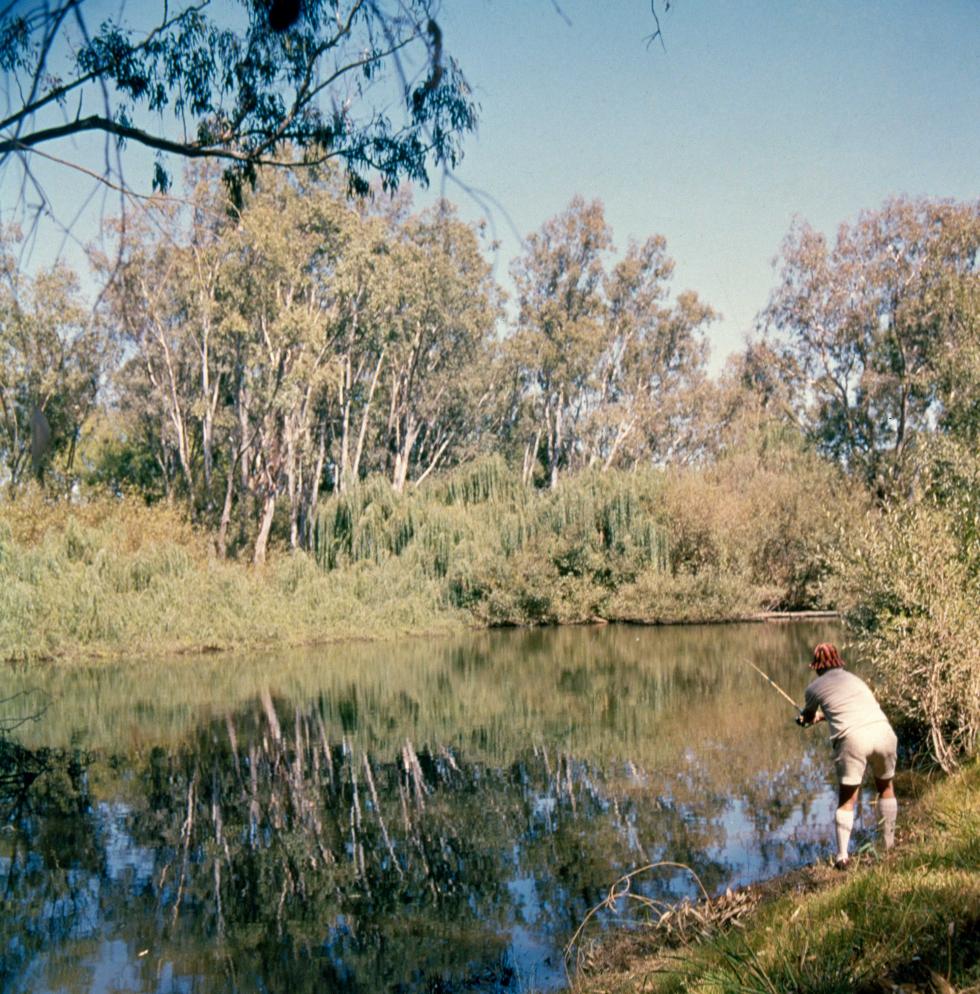


About this record
This colour photograph shows a man fishing on a picturesque stretch along the upper reaches of the Murray River in New South Wales. A large number of eucalypts is visible on the river banks, as is the invasive English willow, and both are reflected in the still water. The angler has cast off from the bank of the river and is probably fishing for the common rainbow trout and perhaps also for the more elusive brown trout.
Educational value
- This image shows fishing in the Murray River at a time when catches were larger and the river, especially its banks, was in better condition than it is today. Irrigation, weirs, snag removal, introduced species (including European carp), overfishing and generally poor river management have led to a decline over the years. Bank erosion is now relatively common, with between 16 and 61 per cent of the total bank length in different localities in New South Wales showing signs of erosion.
- The photograph was taken in the upper reaches of the Murray River, somewhere along the stretch between where the river rises as three clear springs 40 kilometres south of Mount Kosciuszko and where it flows into Hume Lake. This 305-kilometre stretch of river flows through farmland, open country and areas of low-growing forest. Here the river is generally 40 to 50 metres wide with pools 2 metres deep although there are some reaches with pools 4 to 5 metres deep.
- The angler seen here was casting for trout and so would have been using the fibreglass fishing rod and simple spinning reel that were common at the time. Trout fishing requires a lightweight but sturdy fishing rod, one that is easily manoeuvrable but will hold a trout on the line. The spinning reel continues to be the most common type of reel used for trout fishing, and although the line can easily become tangled, it remains the first choice for casting.
- This area of the Murray River, upstream of Hume Lake, is classified as general trout water and carries both brown trout (Salmo trutta) and rainbow trout (Oncorrhynchus mykiss) weighing up to 1.5 kilograms. Both species of fish were introduced to Australia for recreational fishing, the brown trout in 1868 and the rainbow trout in 1894. Like other introduced species they do damage the environment, competing with indigenous species for food and habitat.
- The rainbow trout caught along this part of the river are popular targets for recreational fishing, being more easily caught than the elusive brown trout, which are generally preferred by serious anglers. Trout prefer cool upland streams and pools, and this is where anglers seek them. Their diet contains freshwater insect larvae, crustaceans, snails, small fish and wind-blown terrestrial insects; anglers design their lures and baits accordingly.
- This tranquil image of a solitary angler would have helped spread the message of the benefits of the Australian lifestyle internationally. The photograph was taken by a photographer from the Australian News and Information Bureau (ANIB), an Australian Government organisation set up in 1950 to promote the Australian way of life overseas. ANIB photographers travelled to all parts of the country to take photographs of everyday Australian life.
Acknowledgments
Learning resource text © Education Services Australia Limited and the National Archives of Australia 2010.
Related themes
Need help with your research?
Learn how to interpret primary sources, use our collection and more.



